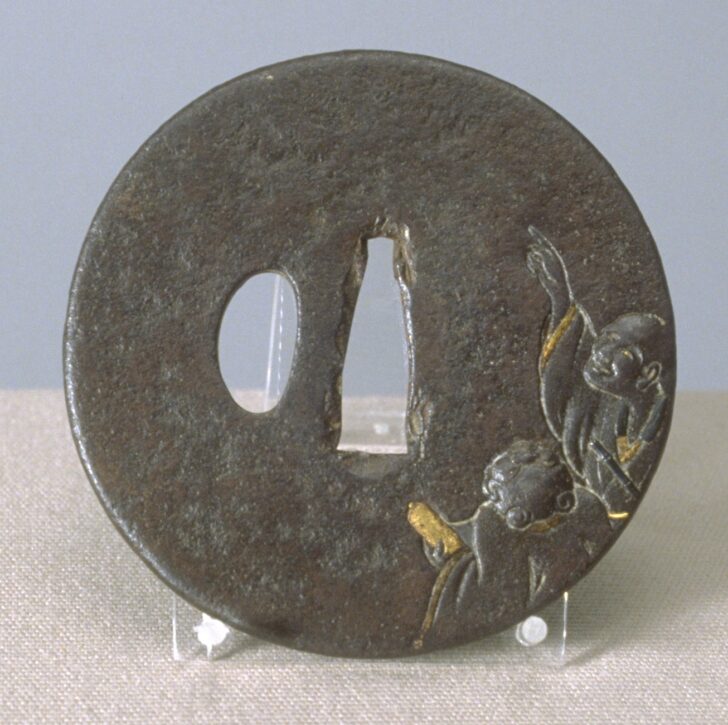Tsuba (sword guard) with design of Kanzan (Chinese, Han Shan) and Jittoku (Chinese, Shihde), two Zen eccentrics
Japanese

Description
Tsuba are intended to protect the user’s hand, first by shielding it against a blow from the opponent’s blade, and second by preventing it from slipping onto the razor-sharp edge of the weapon being wielded. Until the early seventeenth century, simply designed iron tsuba were dominant, as seen in the example here bearing a mushroom motif. When the Tokugawa regime required samurai warlords to travel regularly to the capital, Edo, and mandated that their wives and children reside there, considerations of urban fashion became more influential than battlefield practicalities in samurai attire and accessories. The tsuba became more an object of display than a functional item—a trend that further intensified when affluent merchants were permitted to carry swords in public and also began to demand attractive tsuba.
As is well represented by this collection, there was great artistic creativity at play in tsuba-making during the Edo period. The newly developed shakudô (a copper–gold alloy of a lustrous purple–black color) was used to create relief designs. Openwork chiseling was a versatile method for creating dramatic representations of family crests or light, airy, and elegant plant motifs.
(Label for UMMA Japanese Gallery Opening Rotation, March 2009)
Subject Matter:
Kanzan and Jittoku are Taoist eccentrics of whom little is known, but they are frequently represented (almost always together) in East Asian arts. Both lived in the monastery of Kuo Ching, spending most of their time in the kitchen, and speaking a gibberish unintelligible to anyone, resenting visitors, and noticing them only with insults. Kanzan holds a scroll, which he expounds to Jittoku, who stands by leaning on his broom. Both have a dwarfed and somewhat boyish appearance, but Kanzan's face is furrowed by age. (Reference: Edmunds, Will H. Pointers and Clues to the Subjects of Chinese and Japanese Art).
Physical Description:
Circular tsuba, made of iron. It has two holes in the middle. Two figures, Kanzan and Jittoku, are carved on the lower right corner. Kanzan, who holds a scroll on his hand, and Jittoku, who holds a bloom stick and pointing to the sky, are looking upward. The two figures are carved slightly higher than the surface. On the back, there is the moon partially obscured by clouds. Gold and silver alloy inlays are applied to the moon and the clouds. Gold is also inlayed in their eyes, parts of the garments, and Kanzan's scroll. Shakudô (copper-gold alloy) is inlayed in Jittoku's bloom and his jacket collars.
Usage Rights:
If you are interested in using an image for a publication, please visit https://umma.umich.edu/request-image/ for more information and to fill out the online Image Rights and Reproductions Request Form.